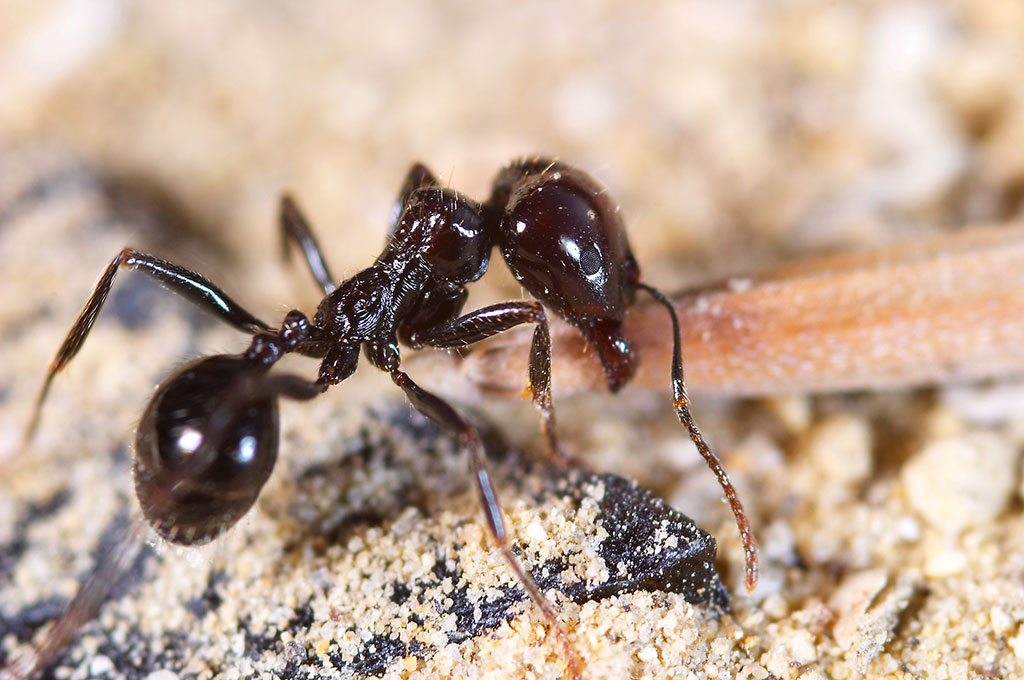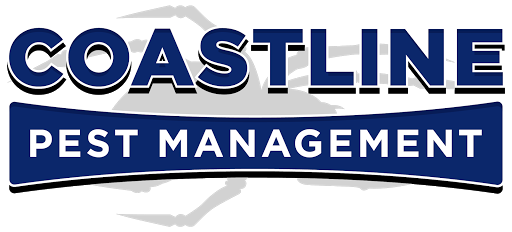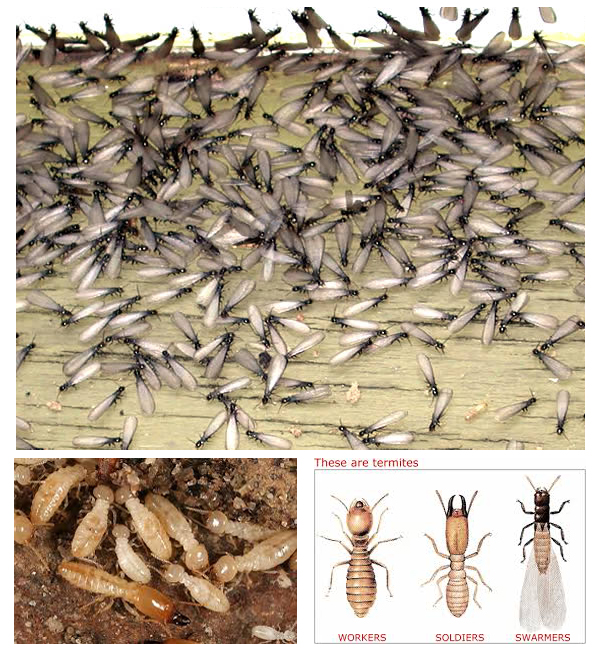
Termites
There are approximately 50 species of termites in the United States. In our area typically we only deal with the Eastern Subterranean Termites.
Eastern Subterranean Termites- Adults are 3/8 inch long. Workers are a dirty white color. Soldiers are a dirty white color except their head is a dark brown to black. Swarmers are black and have two pairs of wings. The wings are clear and almost equal in size. Their wings are also very fragile and will break off shortly after a swarm has occurred.
Termites are social insects, which live in colonies. The eastern subterranean termites’ colony is primarily located in the ground with them foraging into wood. They have three caste that make up their colony. They are: workers, soldiers and reproductive’s. The worker is either a true worker which is sterile. And functional workers which are either male or female. Functional workers have the ability to develop into soldiers or secondary reproductive’s. This depends on the needs of the colony. The soldiers are sterile and their job is to protect the colony from invaders. They have a large head about the size of half their length. They cannot fed themselves because of the mandibles on their enlarge head. It is a job of the workers to feed them. There are two groups of reproductive’s in the colony. Primary reproductive’s are the king and queen that started the colony. Which have wings and can live over 25 years. Secondary reproductive’s do not have wings. They typically are seen in colonies that have matured and are larger in population. A large colony can have as many as a million termites in it.
Bedbugs
Bedbugs have made a comeback in the United States in the past couple decades. After World War II they were pretty much eradicated. Some say the reason for their comeback is the lack of use of toxic pesticides like DDT. And the use of better pesticides focusing on other insects. This with added increase travel has brought them back.
Adult bed bugs are about 3/16 to ¼ inch long. Color is reddish-brown. Their bodies are oval and flat before a feeding. They will inflate or balloon out after a feeding has occurred. Bed bugs do not fly, but are fast crawlers. Babies are a dirty white color to a light tan. They will become darker after a blood meal. And egg will hatch in about 7-9 days at 70* degrees. Then they will go through five molts before becoming an adult. With feedings in between each molt. This typically takes between 32-39 days. If a food source is not available it could take several months. A young bed bug may not survive long periods of time without food in cooler climates. A female may lay as many as 250 eggs in her life. A bed bug bite will pierce the skin with an elongated beak. Once this occurs they will release an anticoagulant toxin. This is done to prevent the blood from clotting. The toxin that is release is what humans have reactions to.
First when traveling you may want to check around your bed and any furniture that seats near the bed. At home don’t be a pack rat. Clutter is great for their hiding. Also be very careful about bring used furniture in your home. It’s best to consult with a professional once you have confirmed you have found bed bugs in your home.
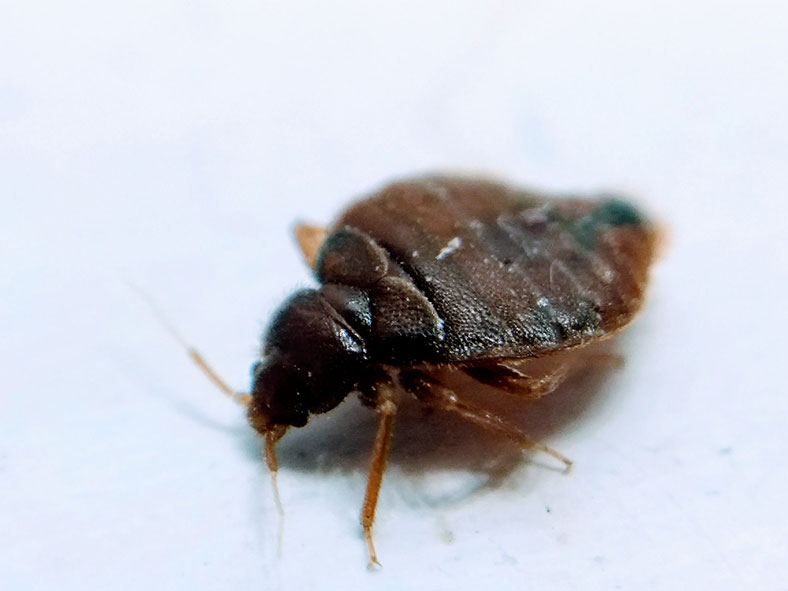

Mosquitos
There are approximately 3000 species of mosquitos world-wide. In South Carolina there are around 50 species of mosquitoes that inhabit various areas. Along the Grand Strand and Low Country we primarily deal with three of these blood thirty pest.
1) Asian Tiger Mosquito- (Aedes albopictus) they are black with white stripes on their abdomen and silver white rings around their legs. They have one set of wings. Which can move 400 to 500 times per second. This is what causes the buzzing noise you hear when they are close. Males only feed on nectar, while females feed on nectar and blood. They need protein from the blood to develop their eggs. Females will lay their eggs in still water. Artificial containers such as kid toys, old tires and birdbaths make great breeding locations for Asian Tiger mosquitoes. They can carry disease such as dengue fever, encephalitis and West Nile.
2) Yellow Fever Mosquito- (Aedes aegypti) they are dark brown to black with silvery white rings and a stripe pattern on their bodies. Yellow fever mosquitoes look very similar to Asian Tiger. They thrive in temperatures above 70*. And are native to the African forest. They will live between two to four weeks. Females will lay approximately 120 eggs in a single batch. Which will occur four to five times during their life time. They will lay their eggs just above the water line in some form of a counter and when the water floods they will hatch. The eggs can survive for years until the water rises. They not only are carries of yellow fever, but also have been found to carry West Nile, Zika and chikungunya.
3) Southern House Mosquito- (Culex quinquefasciatus) they are a medium-size brown mosquito. They are active at night, and like other species the females feed on blood for protein to lay their eggs. Their eggs are laid in what’s called rafts. Females lay their eggs in standing water at night. The eggs will normally hatch in approximately 30 hours. If the water dries up before they hatch, they will die. It then takes around 36 hours for the larvae to fully develop into an adult. This also depends on temperature. The Southern House is a carrier of many pathogens such as West Nile and St. Louis encephalitis virus. They pose a threat to humans, and domestic and wild animals.
Roaches
Even though there are approximately 70 species of cockroaches in the United States. We only have 5 types here in South Carolina that are problematic.
There are three things cockroaches need for survival, they are food, water and shelter. Cockroaches are also nocturnal, so they are more active at night and is the reason why they prefer dark tight spaces. We group cockroaches in two groups. Small and large, this is also referencing the adult size and not babies. Small roaches such as the German and Brown-banded are more persistent and live primarily indoors. The German cockroach is the most popular in the U.S. They prefer the kitchen and bathrooms but may be found in other areas as well. Large cockroaches such as the American, Smoky-brown and Oriental normally live outdoors but they can live inside. The American and Smoky-brown can fly once they become adults. They are commonly referred to as Palmetto bugs in our area.
Preventive Tips: Try to keep a clean house. Removing trash regularly and keep kitchen sinks and counters clean. Clutter is also conducive for roach harborage. If you start seeing cockroach activity regularly, it’s best to consult a professional
1) German cockroaches- Adults are about ½ to 5/8 inch long. Light brown to tan in color. A German cockroach will become a full grown adult in 36 days. In the right environment, a female can produce several hundred babies in one year.
2) Brown-banded cockroaches- Adults are about ½ an inch long. Color pattern is Light brown and dark brown across the back of the body. They can be found throughout structures in areas such as light switches, closets and even near appliance motors.
3) American cockroaches- Adults are 1 3/8 to 2” inches long. Its color is primarily reddish brown. Males will live around 9 month. Whereas the female can live around 15 months, this varies depending on temperature.
4) Smokey-brown cockroaches- Adults are 1 to 1 ¼ inch long. Colors vary from a shiny brownish black to a dark mahogany. An Adult has wings that just extend past their abdomen. Which makes them good fliers, when needed. They also prefer the outdoors but will come in during seasonal changes. They thrive better in moist areas and will feed on anything of nutritive value.
5) Oriental cockroaches- Adults are 1 to 1 ¼ inch long. Colors vary from shiny black to a dark reddish brown. They have shorter wings than other large cockroaches and do not fly. They also prefer to spend most of their time outdoors. And around structures, they normally don’t go above the first floor. Even though they are called Orientals, they are thought to be from North Africa
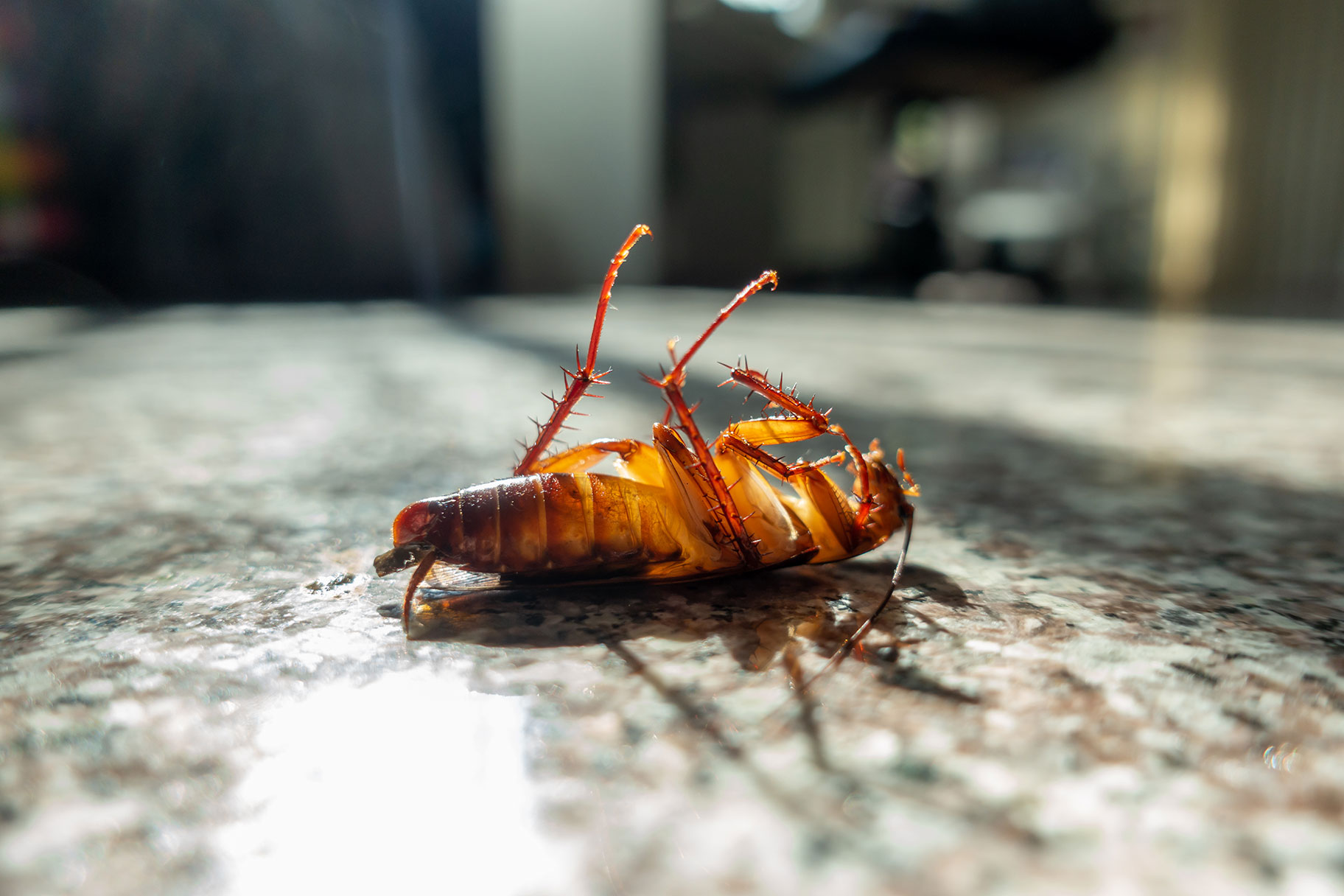

Spiders
There are over 2000 species of spiders found in the United States. Which many can be household pest but we frequently see these six spiders in or around homes and commercial buildings.
1) Wolf Spiders- Adults range in size from 3/8 to 1 ¼ inch long. Color varies from gray and brown to tan and brown with some having black stripes also. These color patterns gives them a very good camouflage in the environment. Wolf spiders are a non-web dwelling spider. They prefer to hunt for their prey. Some wolf spiders will build a burrow to nest in. Some adult females can have legs that spread out as far as 3” inches in diameter. This is why they have been mistaking for tarantulas.
2) Common House Spiders- Adults body length is around 3/16 to 5/16 inch long. Color is yellowish brown with dark spots. This spider is usually the most encountered indoors. Mostly because of its web. The house spider will abandoned its web if it doesn’t yield any prey. Hence the cobwebs found during cleaning. Females lay around 250 eggs in an oval sac which is brown in color. Inside they may be found in upper corners or under furniture.
3) Black Widow Spiders- Adult females’ bodies are about 1/2 inch in diameter. With their legs, their length is 1 ¼ to 1 ½ long. Color is primarily black. Some can be brown and black. Females have a reddish shaped hourglass marking on their underside abdomen. Black widows spin an irregular web and prefer to hang upside down in it. The female widow bite is the most dangerous. Their venom is a neurotoxin and they will get aggressive right after laying an egg sac. Severe pain is associated with their bite. There is an antitoxin available.
4) Cellar Spiders- Adult body lengths are 1/16 to 5/16 inch long and they have thin long legs. Color is pale yellow to light brown or gray. They get their common name from frequently being found in crawlspaces or basements. In our area they are common in some garages as well. They are primarily a nuisance because of their webs. They typically build webs in corners and do not keep their webbing clean. Instead they add new webbing. The Cellar spider will also rapidly shake its web when disturbed.
5) Funnel Web Spiders- Adults body size ranges from 3/8 to 5/8 inch long. Color pattern is usually a dark brown back section with brown and tan stripes appearing on the front section of the spider. They have a flat sheet like web that ends in a funnel. Unlike the wolf spider, which they have been mistaken for they spend most of their time in their web. This spider is not to be confused with the Australian Funnel Spider. None of the Funnel Web spiders inhabiting the United States should be considered dangerous. They may venture in on cold nights when seasonal changes start occurring. Outdoors their webs can be found in tall grassy areas and around bushes in the landscaping. Their webs are also visible on dewy mornings.
6) Zipper Spiders- Adults body size is ¾ to 1 ¼ inch long. And with their legs stretching to almost 3 inches long. Colors are primarily black and yellow on their body. With silver hairs visible on their front section. Being an Orb weaver, they have a unique third claw on their legs to assist with building their complex webs. Their webs are large and normally has a zig-zag pattern in the center of the web. Other common names for this spider is The Garden spider or Writer spider. Some say the zig-zag pattern in the center is for stabilizing the web and others say it is to attract insect by reflection of light.
Ants
There are over five hundred species of ants that have been found in the United States. Of these, there are only six that we commonly call pest.
Ants are social insects which makes them one of the most successful groups of insects. Most ant colonies can be found in the ground but some species will nest in structures, mostly wall voids. There are three cast in a colony, the workers, queens and males. There may be several females in the workers and queens but only one founding queen. Queens are typically larger than the other ants in the colony. And they will have wings for a period of time. Mated female ants chew their wings off. Ants will regurgitated solid food and create a process which develops a liquid food for the colony.
One preventive measure is removing potential food sources. If this isn’t possible then applying insecticide barriers and using baits to control their activity around structures will reduce their chances of getting in.
1) Fire ants- Adults are 1/16 to ¼ of an inch long. Their color is typically yellowish red and black. We have two species of fire ants in our area. The Southern Fire Ant and the Imported Fire Ant. The southern will nest near structures or wood piles and landscape materials. The Imported Fire ant normally will nest out in the open. But can be found up next to structures and in meter boxes. Each colony has its own territory.
2) Odorous house ants- Adults are 1/16 to 1/8” an inch long. Color is brown to black. It gets its’ name from the rotten coconut like odor that is given off when the ant is crushed. They are native to the United States and can have as many as 100,000 ants in large colonies. They typically move along in trails. They prefer sweets but will eat foods high in protein. They are more likely to enter your home after fall or during a rainy season.
3) Argentine ants- Adults- are 1/16 to 1/8” an inch long. Color varies from light to dark brown. These ants do not have a stinger but will bite when provoked. Their colonies are located in moist areas and when foraging they will travel in trails. Their preferred food is sweets (honeydew) but they will feed on proteins as well. They will enter homes when their outdoor food sources are decreased.
4) Pavement ants- Adults are 1/16 to 1/8” an inch long. Color is light brown to black with paler legs. They get their name from commonly making nest under and around pavement and concrete slabs on grade. Their colonies are typically small. Pavement ants may build their nest in wall voids too. They will travel in trails and eat almost any food source available.
5) Carpenter ants- Adults are 1/8 to ½ an inch long. Color is primarily black. They get their name because they hollow out galleries in wood to create a nesting area. Most carpenter ants start their nest in wood that has started decaying from moisture. They will expand the galleries into sound wood that has not been damaged yet by the elements. The continued hollowing out of wooden beams may result in structural damage. Carpenter ants mostly feed on honeydew from plants and some insects.
